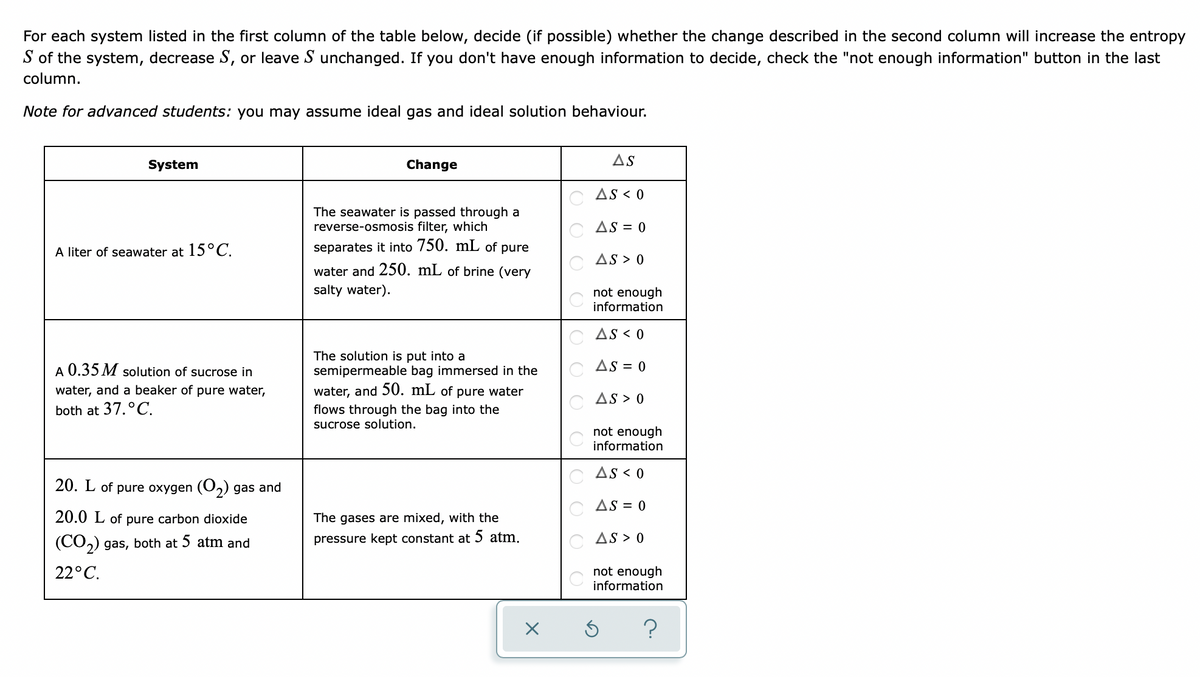For each system listed in the first column of the table below, decide (if possible) whether the change described in the second column will increase the entropy S of the system, decrease S, or leave S unchanged. If you don't have enough information to decide, check the "not enough information" button in the last column. Note for advanced students: you may assume ideal gas and ideal solution behaviour. System A liter of seawater at 15°C. A 0.35 M solution of sucrose in water, and a beaker of pure water, both at 37.°C. 20. L of pure oxygen (O₂) gas and 20.0 L of pure carbon dioxide (CO₂) gas, both at 5 atm and 22°C. Change The seawater is passed through a reverse-osmosis filter, which separates it into 750. mL of pure water and 250. mL of brine (very salty water). The solution is put into a semipermeable bag immersed in the water, and 50. mL of pure water flows through the bag into the sucrose solution. The gases are mixed, with the pressure kept constant at 5 atm. X AS CAS<0 AS = 0 AS > 0 not enough information CAS<0 AS=0 AS > 0 not enough information AS < 0 AS = 0 AS > 0 not enough information 15 ?
For each system listed in the first column of the table below, decide (if possible) whether the change described in the second column will increase the entropy S of the system, decrease S, or leave S unchanged. If you don't have enough information to decide, check the "not enough information" button in the last column. Note for advanced students: you may assume ideal gas and ideal solution behaviour. System A liter of seawater at 15°C. A 0.35 M solution of sucrose in water, and a beaker of pure water, both at 37.°C. 20. L of pure oxygen (O₂) gas and 20.0 L of pure carbon dioxide (CO₂) gas, both at 5 atm and 22°C. Change The seawater is passed through a reverse-osmosis filter, which separates it into 750. mL of pure water and 250. mL of brine (very salty water). The solution is put into a semipermeable bag immersed in the water, and 50. mL of pure water flows through the bag into the sucrose solution. The gases are mixed, with the pressure kept constant at 5 atm. X AS CAS<0 AS = 0 AS > 0 not enough information CAS<0 AS=0 AS > 0 not enough information AS < 0 AS = 0 AS > 0 not enough information 15 ?
Physical Chemistry
2nd Edition
ISBN:9781133958437
Author:Ball, David W. (david Warren), BAER, Tomas
Publisher:Ball, David W. (david Warren), BAER, Tomas
Chapter4: Gibbs Energy And Chemical Potential
Section: Chapter Questions
Problem 4.1E: List the sets of conditions that allow dS, dU, and dH of a process in a system act as a spontaneity...
Related questions
Question

Transcribed Image Text:For each system listed in the first column of the table below, decide (if possible) whether the change described in the second column will increase the entropy
S of the system, decrease S, or leave S unchanged. If you don't have enough information to decide, check the "not enough information" button in the last
column.
Note for advanced students: you may assume ideal gas and ideal solution behaviour.
System
A liter of seawater at 15°C.
A 0.35 M solution of sucrose in
water, and a beaker of pure water,
both at 37. °C.
20. L of pure oxygen (0₂) gas and
20.0 L of pure carbon dioxide
(CO₂) gas, both at 5 atm and
22°C.
Change
The seawater is passed through a
reverse-osmosis filter, which
separates it into 750. mL of pure
water and 250. mL of brine (very
salty water).
The solution is put into a
semipermeable bag immersed in the
water, and 50. mL of pure water
flows through the bag into the
sucrose solution.
The gases are mixed, with the
pressure kept constant at 5 atm.
X
AS
AS < 0
AS=0
AS > 0
not enough
information
OAS<0
AS=0
OAS >0
not enough
information
OAS<0
AS = 0
AS > 0
not enough
information
S
Expert Solution
This question has been solved!
Explore an expertly crafted, step-by-step solution for a thorough understanding of key concepts.
Step by step
Solved in 2 steps

Knowledge Booster
Learn more about
Need a deep-dive on the concept behind this application? Look no further. Learn more about this topic, chemistry and related others by exploring similar questions and additional content below.Recommended textbooks for you

Physical Chemistry
Chemistry
ISBN:
9781133958437
Author:
Ball, David W. (david Warren), BAER, Tomas
Publisher:
Wadsworth Cengage Learning,

Physical Chemistry
Chemistry
ISBN:
9781133958437
Author:
Ball, David W. (david Warren), BAER, Tomas
Publisher:
Wadsworth Cengage Learning,